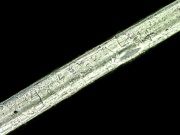Vinyon fiber
Description
A generic name for a manufactured fiber in which the fiber-forming substance is any long chain synthetic polymer composed of at least 85% by weight of vinyl chloride units (Federal Trade Commission definition). Originally, Vinyon was a trademark of Union Carbide for polyvinyl chloride fibers copolymerized with Acrylonitrile called Vinyon N. Soon other variations of PVC polymers and copolymers called Vinyon were developed. By the 1950s, FTC adopted the name vinyon as a general term for PVC fibers. Vinyon fibers have good resistance to chemicals, bacteria, and insects. They soften at low temperatures and are often used to bond other fibers into nonwoven fabrics and to make heat sealable paper. They are used as flame-resistant fibers in children's clothing, blankets, draperies, and carpeting. Vinyon fibers are also used in fishing nets, twines, felts, and industrial fabrics such as tarps, awnings, and outdoor furniture.
Synonyms and Related Terms
vinyon fibre; poly(vinyl chloride) fiber; polyvinyl chloride; chlorofiber; Fibravyl [Rhone-Poulenc Textile, France]; Retractyl; Rhovyl®; Thermovyl®; Leavin [ACSA, Italy]; Clevyl®; Teviron [Japan]; Valren; Viclon [Japan]; Movil [Societa Polymer, Italy]; Vinyon HH [Avtex]; Volpex®
Risks
- Degrades with heat and light to produce hydrochloric acid.
- May also form carbon monoxide or phosgene.
Physical and Chemical Properties
- Soluble in chlorinated hydrocarbons and aromatic solvents
- Insoluble in water, alcohols, concentrated acids and alkalis
- Burns with green flame and evolves HCl
- Cross section is irregular: polygonal, round or dogbone
- Tenacity = 0.7-3.0 g/denier
- Elongation 12-125 %
- Moisture regain =
- Melting Point = 52 C (softens)
- Density = 1.38-1.43 g/ml
Comparisons
Properties of Synthetic Fibers
Resources and Citations
- G.S.Brady, Materials Handbook, McGraw-Hill Book Co., New York, 1971 Comment: p. 851
- Richard S. Lewis, Hawley's Condensed Chemical Dictionary, Van Nostrand Reinhold, New York, 10th ed., 1993
- Hoechst Celanese Corporation, Dictionary of Fiber & Textile Technology (older version called Man-made Fiber and Textile Dictionary, 1965), Hoechst Celanese Corporation, Charlotte NC, 1990
- Rosalie Rosso King, Textile Identification, Conservation, and Preservation, Noyes Publications, Park Ridge, NJ, 1985
- Marjory L. Joseph, Introductory Textile Science, Holt, Rinehart and Winston, Fort Worth, TX, 1986
- J.Gordon Cook, Handbook of Textile Fibres:II Man-made Fibres, Merrow Publishing Co., Durham, England, 1984. p.444.

